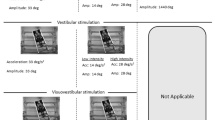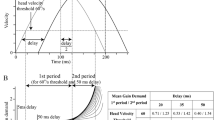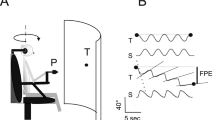Abstract
This work presents a simulation study using an anatomically relevant model of the vestibulo-ocular reflex (VOR). The aim is to explore the functional properties of a bilateral structure in the premotor circuits of the oculomotor system. The major conclusions using sinusoidal inputs are: A bilateral structure in a sensory-motor system improves its linear range beyond expected central limits, if provided with symmetric interconnections. Given a bilateral (push-pull) sensory arrangement, non-linear sensor characteristics are actually advantageous. The greatest improvement in linear range of the reflex (here VOR) relies on intact sensors on both sides. In the case of a single sensor (unilateral head velocity input), or unmatched bilateral sensors, this study predicts a decrease in the linear range and the appearance of a variable bias. These implications are compatible with available data and can be tested in a clinical invironment.
Similar content being viewed by others
References
Baker R, Evinger C, McCrea RA (1981) Some thoughts about the three neurons in the vestibular ocular reflex. In: Cohen B (ed) Vestibular and oculomotor physiology. Ann NY Acad Sci 374:171–188.
Baloh RW, Jacobson KM, Beykirch K, Honrubia V (1989) Horizontal vestibulo-coular reflex after acute peripheral lesions. Acta Otolaryngol (Stockh) [Suppl] 468:323–327.
Berthoz A, Yoshida K, Vidal PP (1981) Horizontal eye movement signals in second-order vestibular nuclei neurons in the cat. In: Cohen B (ed) Vestibular and oculomotor physiology Ann NY Acad Sci: 374:144–156.
Cannon SC, Robinson DA (1985a) Neural integrator failure from brain-stem lesions in monkey. Invest Ophthalmol Vis Sci [Suppl] 26:3–47.
Cannos SC, Robinson DA (1985b) An improved neural-network model for the neural integrator of the oculomotor system: More realistic neuron behaviour. Biol Cybern 53:93–108.
Cannon SC, Robinson DA (1987) Loss of the neural integrator of the oculomotor system from brainstem lesions in monkey. J Neurophysiol 57:1383–1409.
Cheron G, Godaux E (1987) Disabling of the oculomotor neural integrator by kainic acid injections in the prepositus-vestibular complex of the cat. J Physiol 394:267–290.
Cumming BG, Judge SJ (1986) Disparity induced and blur induced convergence eye movement and accomodation in the monkey. J Neurophysiol 55:896–914.
Galiana HL (1987) The implications of the structural modulation in the vestibulo-ocular reflex. Montech '87 Proc. IEEE Conference on Biomedical Technologies; pp 15–18.
Galina HL (1991) A nystagmus strategy to linearize the vestibulo-ocular reflex, IEEE Trans Biomed Eng 38(6): (in press).
Galiana HL, Outerbridge JS (1984) A bilateral model for central neural pathways in vestibulocular reflex. J Neurophysiol. 51:210–241.
Goldberg JM, Fernandez C (1971a) Physiology of the peripheral neurons innervating semicircular canals of the squirrel monkey. I. Resting discharge and response to constant angular accelerations. J Neurophysiol 34:634–660.
Goldberg JM, Fernandez C (1971b) Physiology of the peripheral neurons innervating semicircular canals of the squirrel monkey. II. Response to sinusoidal stimulation and dynamics of peripheral vestibular system. J Neurophysiol 34:661–675.
Goldberg JM, Fernandez C. (1971c) Physiology of the peripheral neurons innervating semicircular canals of the squirrel monkey. III. Variation among units in their discharge properties. J Neurophysiol 34:676–684.
Hain TC, Fetter M, Zee DS (1987) Head shaking nystagmus in patients with unilateral peripheral vestibular lesions. Am J Otolaryngol 8:36–47.
Katsarkas A, Galiana HL, Smith HL (1991) Does the vestibulo-ocular reflex (VOR) merit redefinition? Otolaryngol Head Neck Surgery (in press).
Kearney RE, Hunter IW (1985) NEXSIM: a nexus package for continuous system simulation and parameter estimation. Proc 11th CMBEC, pp 83–84.
Keller EL (1974) Participation of the medial pontine reticular formation in eye movement generation in monkey. J Neurophysiol 37:316–332.
Laurutis VP, Robinson DA (1986) The vestibulo-ocular reflex during human saccadic eye movements. J Physiol Lond 373:209–233.
Lopez-Barneo J, Darlot C, Berthoz A, Baker R (1982) Neuronal activity in prepositus nucleus correlated with eye movement in the alert cat. J Neurophysiol 47:329–352.
McCrea RA, Strassman A, Highstein SM (1987a) Anatomical and physiological characteristics of vestibular neurons mediating the horizontal vestibulo-ocular reflex of the squirrel monkey. J Comp Neurol 264:547–570.
McCrea RA, Strassman A, Highstein SM (1987b) Anatomical and physiological characteristics of vestibular neurons mediating the vertical vestibulo-ocular reflexes of the squirrel monkey. J Comp Neurol 264:571–594.
Nakao S, Sasaki S, Schor RH, Shimazu H (1982) Functional organization of premotor neurons in the cat medial vestibular nucleus related to slow and fast phase nystagmus. Exp Brain Res 45:371–385.
Raphen T, Cohen B, Matsuo V (1978) A velocity storage mechanism responsible for optokinetic nystagmus (OKN), optokinetic afternystagmus (OKAN) and vestibular nystagmus (VN). In: Baker R, Berthoz A (eds) Control of gaze by brainstem neurons. Elsevier, Amsterdam, pp 37–48.
Robinson DA (1971) Models of oculomotor neural organization. In: Bach-y-Rita P, Collins CC (eds) Control of eye movements. Academic Press, New York, pp 519–538.
Robinson DA (1981a) Models of the mechanics of eye movements. In: Zuber BL (ed) Models of oculomotor behaviour and control. CRC Press, Boca Raton/Florida, pp 21–41.
Robinson DA (1981b) The use of control systems analysis in the neurophysiology of eye movements. Ann Rev Neurosci 4:463–503.
Skavenski AA, Robinson DA (1973) Role of abducens neurons in the vestibulocular reflex. J Neurophysiol 36:724–738.
Smith HL (1988) The linearizing properties of a bilateral structure in the vestibulo-ocular reflex — a theoretical and simulation study. M. Eng. Thesis, Dept. Elect. Eng., McGill University.
Smith HL, Galiana HL (1988) Role of structural symmetry in linearizing ocular reflexes. Proc. 14th CMBEC, pp 7–8.
Stockwell CW, Graham MD (1989) Vestibular compensation following labyrinthectomy and vestibular neurectomy. In: Nadol JB Jr (ed) Second International Symposium on Ménière's Disease, Kugler & Ghedini/Amsterdam, pp 489–498.
Takahashi S, Fetter M, Koenig E, Dichans J (1990) The clinical significance of head shaking nystagmus in the dizzy patient. Acta Otolaryngol (Stockh) 109:8–14.
Tomlinson RD, Bahra PS (1986a) Combined eye-head gaze shifts in the primate I. Metrics. J Neurophysiol 56:1542–1557.
Tomlinson RD, Bahra PS (1986b) Combined eye-head gaze shifts in the primate II. Interactions between saccades and the vestibuloocular reflex. J Neurophysiol 56:1558–1570.
Author information
Authors and Affiliations
Rights and permissions
About this article
Cite this article
Smith, H.L.H., Galiana, H.L. The role of structural symmetry in linearizing ocular reflexes. Biol. Cybern. 65, 11–22 (1991). https://doi.org/10.1007/BF00197285
Received:
Accepted:
Issue Date:
DOI: https://doi.org/10.1007/BF00197285




